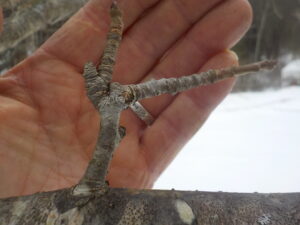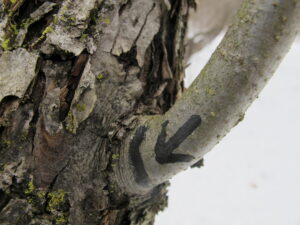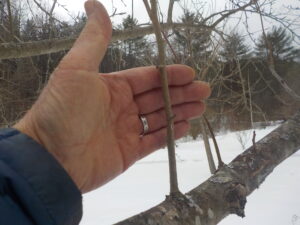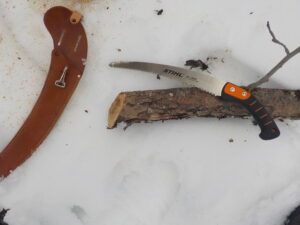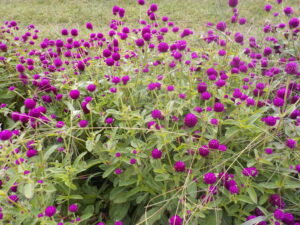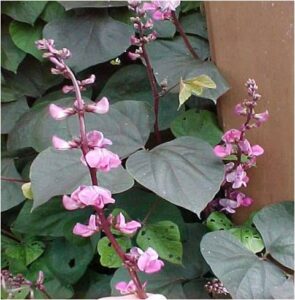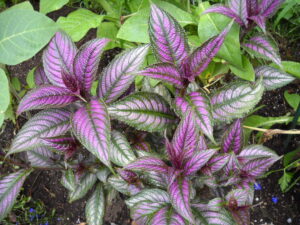Early Spring Chores
Posted on Wednesday, March 29, 2023 · Leave a Comment
Early spring is a good time to look at the trees and shrubs on your property when you are not distracted by flowers and leaves. Study your “woodies” now to see if they need some care– and if some plants need to be removed for the health or beauty of the remaining ones.
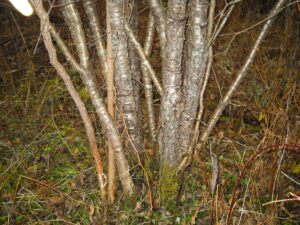
Buckthorn often grows with several stems in a tight grouping
If you have a wooded area on your property, it probably needs some help from you, especially if you haven’t done any thinning or grooming of trees in recent years. Start by going outside and really look at the trees growing on your property with a critical eye.
In nature trees grow willy-nilly. Where a seed lands is largely determined by chance. It is unable to know if it is 6 inches or 6 feet from another tree. If it germinates and grows it might be a good place, or it might be smack-dab next to another tree – or your house.
Ask yourself this question as you walk around your property at your trees: what is the future of this particular tree? How big does this type of tree grow to be? What will this one look like in 10 years? In 50? Is it too close to its neighboring trees or to the house? Is it shading your vegetable garden or favorite flower bed?
I’m a tree-hugger but I have no problem with cutting down trees when judicious removal is beneficial. Now is the time to plan on some careful thinning of trees to improve the health of your best trees and to improve the looks of your landscape.
Before you start tagging trees for culling, you need to learn to identify the trees on your property. A good guide is “A Guide to Nature in Winter” by Donald Stokes, a wonderful book that will help you with that. Because there are no leaves on most trees out there now, the Stokes book is great – it identifies trees by their bark, shape and buds. It also teaches much about all the other living things out there in the woods – from snow fleas to deer and everything in between.
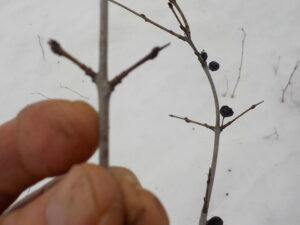
Buckthorns still have black berries and small branches that are sub-opposite (see pair just above my finger) or opposite each other.
Trees that I cull from my woods include poplars (Populus spp.), boxelder (Acer negundo) and alders (Alnus spp.). These are fast-growing trees that are short-lived and that produce lots of seedlings.
Trees that I revere are maples, oaks, beeches, birches and hop hornbeams (Carpinus caroliniana). I would think long and hard about cutting down one of them. But if a fast-growing poplar were growing within six feet of one of my favorites, I would not hesitate to cut the popular down. Trees need plenty of space to do well.
Invasive shrubs make their way into most woods, too. Barberries, burning bush and honeysuckles are shrubs that can choke out native shrubs and many native wildflowers. I work on eliminating those every spring, but the honeysuckles are still ahead of me. Learn to identify them and tag them for removal.
There are a few buckthorns (Rhamnus spp.) moving into the neighborhood, and I am keeping a sharp eye to make sure none get established on my property. Buckthorns are foreign invaders that cannot be easily killed by cutting them down because they sprout up from their roots if you cut them down.
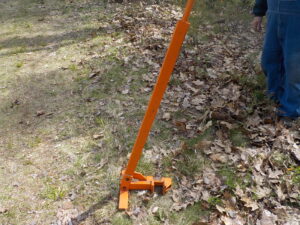
A weed wrench allows anyone to pull out invasive shrubs
To rid your property of buckthorns, you can pull young ones or girdle the older ones. Trees up to about 2.5 inches in diameter can be pulled with a tool designed for that purpose. It is often called a weed wrench, although the original Weed Wrench company has gone out if business. Another brand of weed wrench is called the “Pullerbear”. It is a steel tool with a gripping mouthpiece and a long handle that provides mechanical advantage. They come in several sizes and prices. For more info see www.pullerbear.com. I have not yet tried one of this brand, but they look like the old weed wrenches I have used.
If you cut down a mature buckthorn it will stimulate the roots to send up many suckers that will develop into new trees. To prevent this from happening, you need to girdle buckthorns twice about 12 inches apart. Cut through the bark severing the green cambium layer all the way around the trunk, but don’t cut deeply. They will usually survive two years before dying. Girdling starves the roots of food from the leaves.
You can girdle them now but doing so right after they leaf out in the spring is better. Just tag them now, and plan their demise. Some buckthorns develop multiple stems in a cluster, making it tough to girdle them, but it is possible using a pointed pruning saw.

These trees will never thrive, and most will die from crowding
Hemlocks and pines often grow so densely that their lower limbs die out because the sun never reaches their leaves. Removing those lower branches opens up the landscape – another task you could do now. And think about removing any wild grapes that are climbing your trees – they can kill them.
So enjoy the spring weather and make some plans for real spring.
Bringing Spring into the House
Posted on Wednesday, March 22, 2023 · Leave a Comment
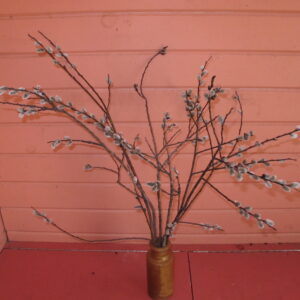
Pussy willows in a dry vase
Even though spring has arrived according to the calendar, I fear winter is not done with us yet. Mother Nature is full of tricks, so I am not packing away my snow shovel just yet. But to reassure me that she will provide us with flowers this spring, I am forcing her hand a bit. Or should I say, forcing some woody stems to blossoms indoors now.
Each spring when winter seems to be carrying on forever, I cut stems of early-blooming trees and shrubs and bring them into the house to enjoy their blossoms. If you wish to try this, you need to know which trees and shrubs to use, and learn to identify buds that will produce flowers, not just leaves.

Forsythia forces easily indoors now
The easiest to force are forsythia and pussywillows. But it is also possible to force magnolias, rhododendrons and azaleas, apples and crabapples, cherries, plums, dogwood, spirea and peach. Of course cutting stems off your young peach or plum tree will reduce your fruit crop.
Trees and shrubs that bloom early in the season are quicker to produce their flowers. Shrubs like hydrangeas that bloom in late summer or fall will not bloom now, no matter what you do. I’ve never had much luck with lilacs, though perhaps if I tried closer to bloom time it would work.
In general, flower buds tend to be bigger and fatter than leaf buds. Apple and crabapple trees produce flower buds on short “fruit spurs” but not on those tall water sprouts that appear each summer. So if you are pruning your apples now, look for branches with short spurs and fat buds. Keep those, and bring them into the house.
I lost a plum tree this winter – it broke under the weight of snow and ice. It took 20 years from the time I planted a bare root twig to the time it first produced fruit. This year it was loaded with fruit spurs and I was looking forward to a big crop of plums. No matter, these things happen. I am making the best of it by cutting lots of stems with fruit spurs and placing them in vases in the house. I should get a multitude of blossoms in a few weeks.
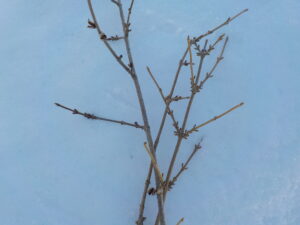
Forsythia with flower buds in pairs
I am also cutting stems from forsythia bushes to bring in the house. Forsythia is one of the first to bloom outside, and one of the easiest to force inside. It produces bright yellow flowers in quantity. Look for branches with pointy buds on stems that are at least 2 years old. You will see skinny new-looking branches that grew last year. They probably won’t produce flowers. Stems that are closer in diameter to pencils are what you want. Older branches have stems growing out of them, often with flower buds.
Then there are the pussy willows. . What we call pussywillows are actually the male catkins – pollen-producing parts – of two species of willows (Salix caprea and Salix discolor). Both grow wild, and are available at nurseries.
Pussy willows, like all willows, like wet, swampy areas. They will grow up to be small trees, but can be kept to a manageable size with yearly pruning – and now is a good time to do so. The more you trim your pussy willows, the more vigorous and productive they will be. Left unpruned, pussy willows can easily reach 20 feet tall. Since they bloom on their upper branches, picking good-looking stems can be difficult unless you have a pole pruner.
An established pussy willow is next to impossible to kill. If you have wild pussy willow that is tall and gangly, you can take a saw and cut it all right to the ground. It will come back. It can grow four feet or more in a single season.
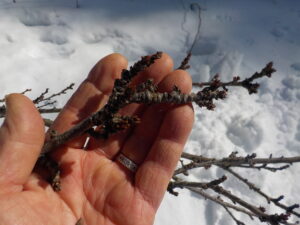
Fruit buds on plum tree
If you see yellow dust on your pussy willows, they are already producing pollen. So if you are allergy-prone, don’t pick stems with yellow on them. But you can halt pussy willows from producing pollen: pick them at their peak of beauty, and place them in a dry vase. They will stay looking the same for a year. If you pick them before they are fully developed, put them in a vase with water to let them mature. Drain off the water when the little gray kitties are at their cutest.
In 2005 I worked as a volunteer on an organic farm in the Dordogne region of France that grew willow for making baskets. I worked through an organization called Willing Workers on Organic Farms (
www.wwoof.org). In exchange for 4-6 hours of work each day I got room and board, lived with a family, and learned a lot about willows – including how easy it is to root them.
To root willows, cut 8-12 inch sections of vigorous young stems in May or June. Strip off the lower leaves, and push the stems into moist soil, leaving just 2 inches above ground. Roots will develop at each node (where leaves start) on the stem below ground; new stems and leaves will grow above ground, so long as you leave at least one node above ground. Depending on your soil, you may need to poke a hole in the ground with a screwdriver before inserting your willow stem; be sure the ground is firmed up around it when you are done.
So cut some stems to flower and chase away the late winter blues. It’s easy, and now is the time to do it.
Ask a farmer, “When should I prune my apple trees?” and you will most likely hear, “March.” That’s an old tradition – but not because it is the only time to prune. You can prune any time. But March is a month on a farm when not so much is happening outdoors, and farmers have time to prune their apples. Me? I often prune in the fall, or later in the spring when the ground dries out and it warms up. I say, “Prune when you have the time and inclination.”
Next, pruning opens up a tree and lets sunshine hit every leaf so that it can produce food for the roots and fruits. A well-pruned tree will be healthier and produced tastier fruit than a neglected tree. My pruning mentor told me decades ago that a bird should be able to fly through a well-pruned apple tree without getting hurt.
When pruning a fruit tree it’s important to know which branches will be blossoming and producing fruit. Look for fruit spurs on apples and pears. These are roughly 3- to 6-inches long protuberances with buds on them. As you prune you will have to make choices about which of two branches to cut. Look for those fruit spurs, and be guided by them.
In general when making cuts on an older, neglected tree, it’s better to remove a few larger branches than trying to make many, many smaller cuts.
Start by removing any dead or damaged branches. Cut them back to the trunk, or to a larger branch where they originate. Heavy wet snow and high winds this winter have created lots of broken branches. Clean them up. Knowing if a small branch is alive is easy: scrape it with your thumbnail. If it show green, it is alive. Bigger dead branches will have flaky, discolored bark and will not be flexible if bent.
Remove any branches that are rubbing other branches. Keep the best looking branch and remove the other. Remove any branch that is headed into the center of the tree instead of growing towards the outside.
Or perhaps you’d like to begin with the easiest branches to remove, the water sprouts. These are vertical shoots coming up from a more-or-less horizontal branch. They are very numerous in some trees, not so much in others.
If water sprouts are not removed when the thickness of a pencil or a hot dog, they will become as thick as your arm or leg and be difficult to remove. So clean those up every year.
You can change the angle of growth of a branch that is only an inch or less thick. Once winter is over, attach string or rope to a branch and tie it to a peg in the ground or to a weight to bend it down. A half-gallon milk jug works well. Just add water until you have the correct angle on the branch. Forty-five to sixty degrees off vertical is fine. You can remove the weights in June. Branches that are 45 degrees from the horizontal produce more fruit than more vertical branches.
If you have to remove a bigger branch, do it in two steps. First make a cut two or three feet out from the trunk to reduce the weight of the branch. Then make a second cut just outside the branch collar. Use one hand on the saw, one hand supporting the weight of the branch. That will prevent tearing the bark on the trunk if it falls before you finish the cut.
When pruning, don’t overdo it. Trees need their leaves to feed the roots and fruit. In any given year don’t take more than 25% of the leaves (woody stems don’t count when calculating how much you have taken off). In winter you just have to estimate how much live wood you can take off.
Pruning is fun. And if you make a mistake, don’t worry. Your tree will grow a new branch to replace the one you removed.











